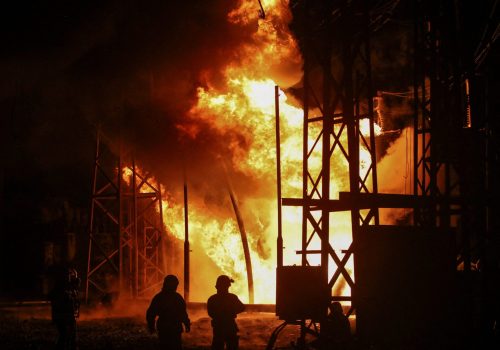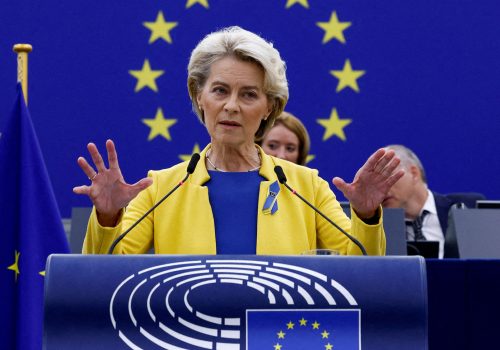Europe and its allies are on high alert following four explosions last week along the Nord Stream 1 and 2 natural gas pipelines. While there is still no definitive answer on who bears responsibility—though seismologists have ruled out anything other than an explosion and European Union (EU) foreign-policy chief Josep Borrell called it a “deliberate act”—many suspect the Kremlin is the culprit.
Either way, the episode shows the United States and Europe must work together to secure critical energy infrastructure from kinetic and cyber threats and respond swiftly as additional information comes to light.
Initially, Russian sabotage may seem counterintuitive in this case. If Russia wanted to prevent gas flowing to Germany, it could have simply withheld supply without damaging future export infrastructure (as it has already done). Yet brazen assaults on infrastructure off the Danish and Swedish coasts could be easily used to spark panic in Europe over future attacks, further destabilize energy markets, and allow conspiracy theories to fester. All are known to be tricks of the Kremlin trade.
Last week’s leaks had an immediate impact on the European gas market, with benchmark futures increasing 22 percent. That response was based on the bigger-picture security implications rather than immediate supply repercussions. There is ample spare capacity for Russian gas exports through the Yamal pipeline and Ukraine’s transit network, and the destruction of the Nord Stream pipelines does not itself impose new supply pressures on Europe.
The most recent incidents did nothing to disrupt the Kremlin’s income, since neither Nord Stream 1 nor 2 was exporting to Europe at the time. They did, however, create enormous uncertainty around competing infrastructure in the immediate region.
Baltic Pipe, which will bring Norwegian gas to Poland, was inaugurated the very same day of the explosion—and in response, Norway was quick to deploy its military to defend its hydrocarbon infrastructure. New liquid natural gas terminals are also being deployed swiftly on the Baltic Sea, including five in Germany alone, and are expected to be completed by the end of 2022. The attacks also come ahead of EU plans to embargo seaborne shipments of oil in December, which the Kremlin would be incentivized to derail by disrupting related fuel markets.
While the explosions have rattled Europe, swift action can minimize the risk of future attacks and ensure security of supply as winter approaches. Here’s what the West can do:
First, NATO must make infrastructure protection a strategic priority. It should articulate clearly that any energy-infrastructure sabotage could trigger the Article 5 mutual-defense pact (much like Secretary-General Jens Stoltenberg declared last June that a cyberattack would do the same). While Stoltenberg said last Thursday an attack on any ally’s critical infrastructure would be “met with a united and determined response,” a much clearer invocation of collective defense could further deter future acts of sabotage. Norway has already received assistance from Britain, France, and Germany to patrol vulnerable energy assets, and the United States should support these efforts with its European-based troops.
Second, the United States should boost existing coordination with its European partners on monitoring cyber and physical threats by increasing intelligence-sharing and combining satellite-monitoring capabilities. NATO’s Cybersecurity Center of Excellence in Tallinn, Estonia, can play an increased role in coordinating cyber intelligence across the Alliance. Washington has an overwhelming interest in ensuring that it can manage Russian threats across all domains, including dangerous behavior by Russian ships and planes in the High North. The United States should bolster its cyber collaboration with Europe through the Department of Energy, the recently launched Department of State Bureau of Cyberspace and Digital Policy, and the Department of Homeland Security’s Cybersecurity and Infrastructure Security Agency.
Expanding the US-EU Technology Council’s cybersecurity guidance, which is mainly focused on small- and medium-sized enterprises, can also help systemic energy infrastructure companies defend against cyber risk.
Third, Europe must assume that these acts of sabotage are a prelude for a full cut-off of Russian gas and plan accordingly. It should therefore step up coordination with the United States on securing new gas supplies from non-Russian sources, switching gas use to other forms of energy, improving energy efficiency, and reducing energy consumption in the short term where possible. But that alone will not suffice: in the immediate term, measures to ration gas among non-essential users will need to be taken across Europe to help with addressing a worst-case scenario if all Russian gas flows are cut off.
Last week’s brazen attacks on the Nord Stream pipelines have jolted Europe. But they must also galvanize the next level of transatlantic cooperation on physical and supply security. By working closely together, Washington and Brussels can protect energy assets, build a more secure energy system for the future, and proceed unfettered to redouble their support for Ukraine.
Olga Khakova is the deputy director for European energy security at the Atlantic Council’s Global Energy Center.
Paddy Ryan is the assistant director for European energy security at the Global Energy Center.
Elina Carpen is a fall 2022 young global professional at the Global Energy Center.
Further reading
Mon, Oct 3, 2022
European unity is essential as Putin prepares to weaponize winter
UkraineAlert By
European unity will be vital in the coming months as Russia attempts to weaponize winter in order to convince EU leaders to abandon their support for Ukraine and end their opposition to Vladimir Putin's ongoing invasion.
Tue, Sep 27, 2022
Putin threatens to increase attacks on Ukraine’s civilian infrastructure
UkraineAlert By
Vladimir Putin has threatened to destroy Ukrainian civilian infrastructure in a targeted campaign designed to crush the country's will to resist the ongoing Russian invasion.
Thu, Sep 15, 2022
What’s next for European energy security? Our experts decipher the State of the European Union Address.
Markup By
Ursula von der Leyen's speech focused on energy and strategic decoupling of supply chains amid Russia's war in Ukraine, but didn't delve into common defense.
Image: Photo provided by the Swedish Coast Guard on September 28, 2022 shows a gas leak on the Nord Stream 1 pipeline. Photo by the Swedish Coast Guard via AbacaPress.com and Reuters.



